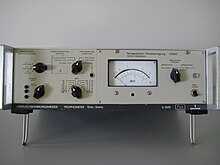Psophometer

A psophometer (from ancient Greek ψόφος psóphos 'noise, noise' as well as μέτρον métron 'tool for measuring'), also known as a noise voltmeter in German , is a measuring device for the acquisition and quantitative evaluation of the noise of electrical or acoustic signals, which with the help of suitable signal filters ( according to CCIR or CCITT ) can be weighted and assessed. The result of the weighted measurement is usually displayed optically or acoustically and output as a numerical value.
Instruments
Examples of measuring devices with a psophometer function are the modulation analyzers FMA and FMB from the German measuring device manufacturer Rohde & Schwarz (R&S), the U 2033 noise voltmeter (picture) from Siemens , the psophometer 2429 from the Danish manufacturer Brüel & Kjær and the psophometer HP 3556A from the former American measurement technology company Hewlett-Packard (HP), from which Agilent was spun off in 1999 and Keysight was created in 2014 .
literature
- H. R. Harbottle: The circuit noise-meter (psophometer) and its applications. Journal of the Institution of Electrical Engineers (IEE), Volume 83, Issue 500, August 1938, pp. 261-274, doi: 10.1049 / jiee-1.1938.0142
Web links
- Psophometer HP 3556A in the Museum of Telecommunications, accessed on November 27, 2018.
- Psophometer Brüel & Kjær 2429 in the Radio Museum , accessed on November 27, 2018.
- Psophometer for Use on Telephone-type Circuits. ITU -T Recommendation O-41, 1994, PDF; 122 kB (English), accessed on November 27, 2018.
Individual evidence
- ^ Wilhelm Gemoll: Greek-German school and hand dictionary. Munich / Vienna 1965.